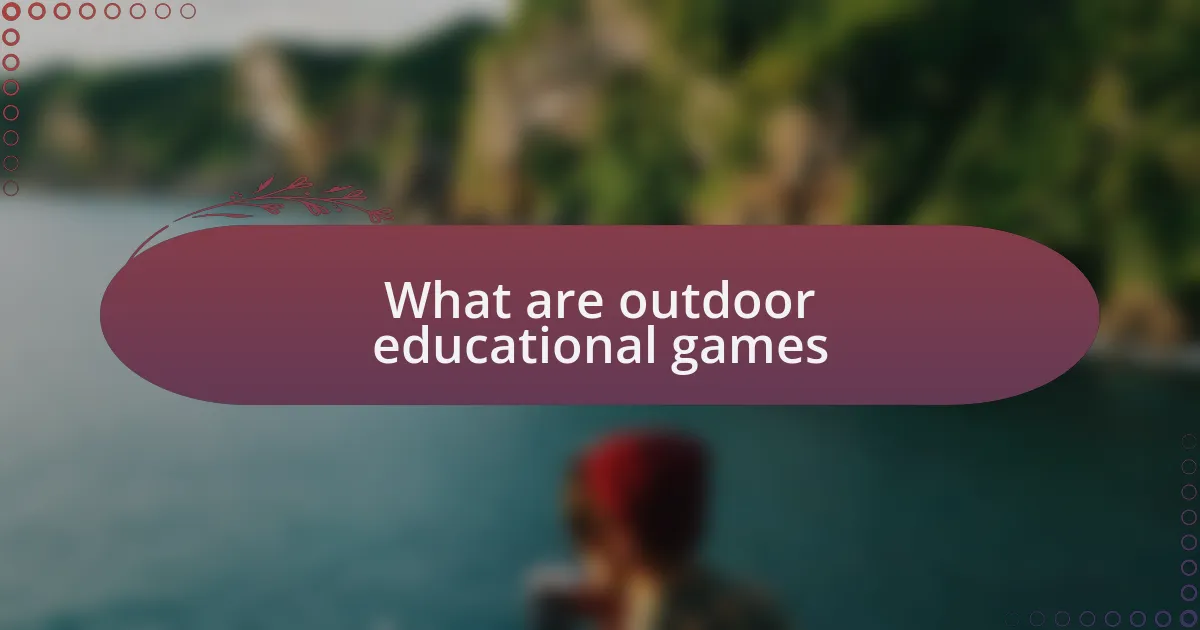Key takeaways:
- Outdoor educational games enhance learning by engaging students in active experiences outside, promoting teamwork and critical thinking.
- These activities improve observational skills, build resilience through challenges, and deepen connections with nature.
- Essential materials like balls, cones, and first aid kits are crucial for safety and maximizing engagement during outdoor games.
- Adaptability and consideration of children’s interests are vital for creating inclusive and memorable outdoor learning experiences.

What are outdoor educational games
Outdoor educational games are activities designed to engage students in academic learning while they are outside. These games transform traditional learning methods into active experiences, encouraging teamwork, critical thinking, and problem-solving. I remember one summer day, leading a group in a scavenger hunt that incorporated biology concepts. The thrill of discovering a unique plant or identifying a bird species really sparked curiosity and made the learning stick.
What truly sets outdoor educational games apart is their ability to tap into children’s innate love for movement and exploration. Have you ever seen how excited kids become when they run freely in nature? It’s infectious! These games not only foster physical activity but also promote social skills as children collaborate and communicate, enhancing their emotional intelligence in a natural setting.
Moreover, incorporating elements of competition can add an exciting twist. For instance, I once set up a math relay race where students solved problems at different stations. The combination of running and learning created an exhilarating atmosphere. Can you imagine the sense of accomplishment they felt when they crossed the finish line, not just having fun but having learned something valuable along the way?

Benefits of outdoor educational games
Engaging in outdoor educational games offers numerous benefits that extend beyond the classroom. One of my favorite aspects is how these activities sharpen observational skills. I recall overseeing a mini-biodiversity investigation where students documented various plant species. Watching them crouch down, pen in hand, intensely focused on details they would typically overlook indoors was truly impressive. It reminded me that learning isn’t confined to textbooks; it happens when we open our eyes to the world around us.
Another significant advantage is building resilience through challenges. For example, while leading an obstacle course that required critical thinking and collaboration, I witnessed students overcoming their initial hesitation. They learned to embrace failures as learning opportunities, which is invaluable. Have you ever noticed how tackling a tough problem outdoors can boost confidence? The sense of achievement after completing a tricky task in a real-world setting can be transformative.
Additionally, outdoor educational games foster a deeper connection with nature. I’ve seen students develop a genuine appreciation for the environment while participating in tree identification games. This connection sparks a desire to learn more about conservation and ecology. Doesn’t it feel fulfilling when children not only enjoy themselves but also cultivate respect for their surroundings? This holistic growth is why I advocate for integrating outdoor experiences into education.

Essential materials for outdoor games
When planning outdoor educational games, having the right materials is crucial for maximizing engagement and learning. Basic items such as balls, cones, and ropes can transform a simple game into an exciting challenge that keeps kids motivated. I remember once when we used colorful cones to create a wildlife sanctuary relay—students sprinted back and forth, all while learning about different species. Those cones quickly became not just markers, but a gateway to learning!
Another essential material I’ve found beneficial is a first aid kit. It might seem obvious, but when you’re outdoors, the unpredictable can happen. During one field day, a minor scrape could have derailed the fun, but with the first aid supplies at hand, we were able to swiftly handle the situation, refocusing the group on learning while ensuring everyone felt safe. How often do we consider safety when we’re planning fun, educational adventures?
Finally, let’s not overlook the importance of creative props or educational guides that align with the game’s objectives. Whether it’s binoculars for a bird-watching scavenger hunt or worksheets for documenting findings, these tools can enhance the overall experience. I once facilitated a treasure hunt using maps and hand-made clues, and the excitement on the students’ faces when they found “hidden treasures” was priceless. What materials have you used to elevate outdoor learning experiences?

My top outdoor educational games
One of my favorite outdoor educational games is the “Nature Scavenger Hunt,” which encourages kids to explore their surroundings while learning about local flora and fauna. I remember organizing this in a community park, and the joy on the children’s faces as they discovered unique leaves, insects, and even bird feathers was contagious. This activity not only fosters curiosity but also enhances observation skills—how amazing is it to see children so genuinely excited about the natural world?
Another standout is the “Math Relay,” which combines physical activity with problem-solving. I’ve seen teams race to complete math challenges at different stations, and it’s thrilling to watch their competitive spirit ignite. They sprint back and forth, shouting out answers and working together. I often wonder, how can we make math this exhilarating indoors? The energy and camaraderie created during these relays highlight how outdoor activities can change the mundane into a memorable learning experience.
Lastly, there’s the “Storytelling Circle,” a game that merges creativity with teamwork. I recall one session where each child contributed to a collaborative story while sitting in a circle beneath a tree. The twist? They had to incorporate elements of their surroundings into the tale. This not only sparked their imagination but also strengthened their communication skills. Isn’t it fascinating how such simple activities can build complex skills?

Tips for playing outdoor games
When planning outdoor games, it’s essential to consider the age and interests of the participants. I remember a day spent with a group of younger kids who were hesitant to engage in a game. After a brief discussion, we decided to incorporate animal movements—crawling like bears and hopping like frogs—into our games. This small tweak not only piqued their interest but also turned the activity into a delightful adventure of imagination. Could the secret to engaging children lie in their natural instincts?
Safety should always be a priority, especially when there’s a lot of running around. I’ve learned to set clear boundaries for the play area before games start, ensuring no one wanders into dangerous spots. One time, during a game of “Capture the Flag,” I realized we had moved too close to a busy road without noticing. That experience taught me the importance of constantly monitoring the environment while the fun unfolds. Isn’t it better to prevent any mishaps rather than to handle a crisis later?
Encouraging team collaboration can transform a simple game into a profound learning experience. During a spirited round of “Treasure Hunt,” I noticed how the kids began to strategize together, dividing tasks and sharing findings. Their giggles and shouts of excitement as they achieved little victories together were priceless. I often ask myself, what if we harness this collaborative spirit in every aspect of learning? A sense of teamwork truly elevates the joy of outdoor play.

Conclusion and recommendations
To wrap up our discussion on outdoor educational games, it’s crucial to immerse children in activities that resonate with their interests and energy levels. I once organized a scavenger hunt in a local park, which combined the thrill of discovery with cooperative learning. Watching the kids’ eyes light up as they uncovered hidden treasures reminded me just how effective play can be for engaging young minds.
I highly recommend considering the various learning styles of participants when selecting games. For instance, some children thrive on physical activity, while others might favor problem-solving or creativity. I recall adjusting a game to incorporate both movement and critical thinking after noticing a few kids felt left out. This approach not only allowed everyone to contribute but also fostered an inclusive environment that enhanced their overall experience—wouldn’t you agree that every child deserves to shine?
As you implement these games, keep adaptability at the forefront. I vividly remember how one rainy day we transitioned an outdoor game into an interactive storytelling session under a pavilion, sparking even more enthusiasm among the group. This adaptability not only keeps the energy high but also ensures that learning continues, no matter the circumstances. After all, isn’t it the unexpected moments that often create the most memorable learning experiences?